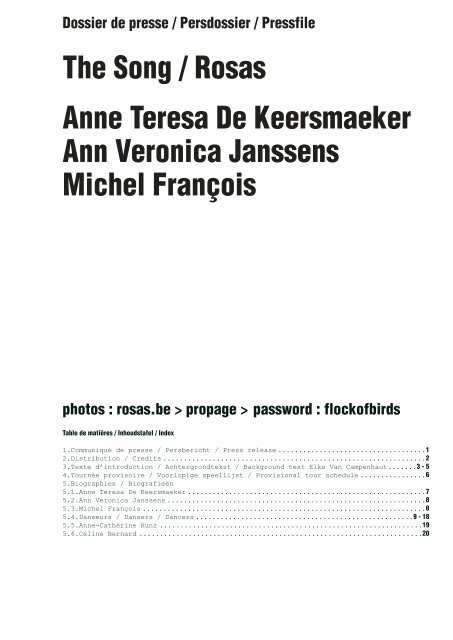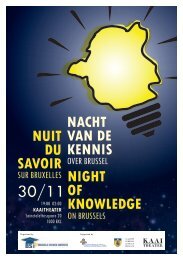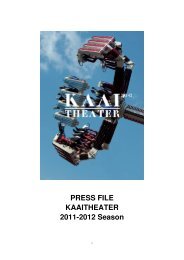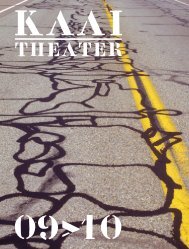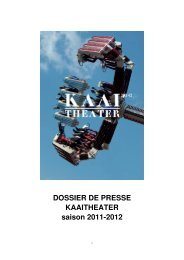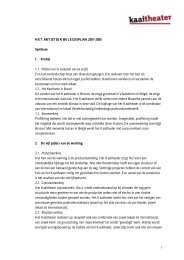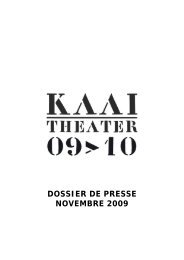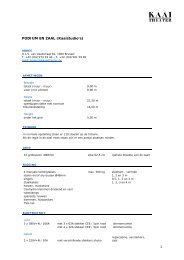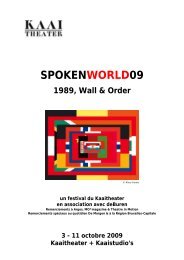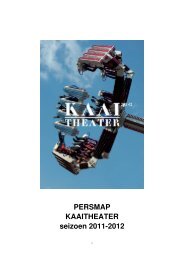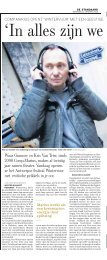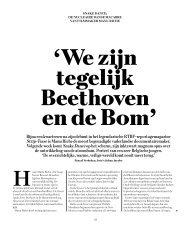5.2. Ann Veronica Janssens - Kaaitheater
5.2. Ann Veronica Janssens - Kaaitheater
5.2. Ann Veronica Janssens - Kaaitheater
Create successful ePaper yourself
Turn your PDF publications into a flip-book with our unique Google optimized e-Paper software.
Dossier de presse / Persdossier / Pressfile<br />
The Song / Rosas<br />
<strong>Ann</strong>e Teresa De Keersmaeker<br />
<strong>Ann</strong> <strong>Veronica</strong> <strong>Janssens</strong><br />
Michel François<br />
photos : rosas.be > propage > password : flockofbirds<br />
Table de matières / Inhoudstafel / Index<br />
1.Communiqué de presse / Persbericht / Press release ....................................1<br />
2.Distribution / Credits ................................................................2<br />
3.Texte d’introduction / Achtergrondtekst / Background text Elke Van Campenhaut.......3 - 5<br />
4.Tournée provisoire / Voorlopige speellijst / Provisional tour schedule ................6<br />
5.Biographies / Biografieën<br />
5.1.<strong>Ann</strong>e Teresa De Keersmaeker ..........................................................7<br />
<strong>5.2.</strong><strong>Ann</strong> <strong>Veronica</strong> <strong>Janssens</strong> ...............................................................8<br />
5.3.Michel François .....................................................................8<br />
5.4.Danseurs / Dansers / Dancers .....................................................9 - 18<br />
5.5.<strong>Ann</strong>e-Cathérine Kunz ................................................................19<br />
5.6.Céline Bernard .....................................................................20
© Herman Sorgeloos
FR<br />
Le 17 septembre La Monnaie et <strong>Kaaitheater</strong> présenteront la première belge de « The Song » au <strong>Kaaitheater</strong> à Bruxelles. Cette<br />
nouvelle création d’<strong>Ann</strong>e Teresa De Keersmaeker est une production de Rosas en coproduction avec La Monnaie / De Munt, Théâtre<br />
de la Ville, Grand Théâtre de Luxembourg et Concertgebouw Bruges.<br />
« The Song » évoque un monde qui court à toute allure, de plus en plus vite, jusqu'à se dépasser. L'accélération est trop forte : on<br />
sent qu'il va caler. Au cœur du tourbillon, dans l'œil du cyclone, il y a pourtant nos corps, dernières balises d'une réalité chaotique<br />
et mutante.<br />
« The Song » : dix danseurs évoluent sur un plateau nu, réduit à l'essentiel. N'y subsistent que les unités élémentaires du théâtre -<br />
lumière, son, mouvement. L'espace que découpe <strong>Ann</strong>e Teresa De Keersmaeker, en collaboration avec les artistes <strong>Ann</strong> <strong>Veronica</strong><br />
<strong>Janssens</strong> et Michel François, est un désert. Un pays aride d'où émergent des hypothèses : un solo de joie nue, un corps en quête de<br />
sa dernière légèreté; ou un mouvement d'ensemble profilé comme une nuée d'oiseaux, dont l'infinie variation des motifs évoque<br />
tout à la fois la formule mathématique et la pure fantaisie humaine.<br />
Représentations au <strong>Kaaitheater</strong> les 17-19, 23-26 septembre à 20h30, le 27 septembre à 15h00. Info & tickets www.kaaitheater.be T<br />
02 201 59 59 of www.demunt.be T 070 23 39 39<br />
Du 5 septembre au 15 novembre 2009 Wiels organise une exposition solo de <strong>Ann</strong> <strong>Veronica</strong> <strong>Janssens</strong>. Les billets pour <strong>Ann</strong> <strong>Veronica</strong><br />
<strong>Janssens</strong> au Wiels donnent droit à un tarif réduit pour « The Song » au <strong>Kaaitheater</strong> et vice versa.<br />
Du 9 octobre 2009 au 3 janvier 2010, le S.M.A.K. (le musée d’art contemporain de Gand en Belgique) organise une exposition<br />
rétrospective autour de l’artiste belge, Michel François.<br />
Pour des interviews, des photos ou plus d’informations, veuillez vous adresser à Ilse<br />
Den Hond, presse et communication Rosas, tél 0032 2 344 55 98, ilse.denhond@rosas.be<br />
NL<br />
Op 17 september presenteren De Munt en het <strong>Kaaitheater</strong> de Belgische première van The Song in het <strong>Kaaitheater</strong>. Deze nieuwe<br />
creatie van <strong>Ann</strong>e Teresa De Keersmaeker is een productie van Rosas in coproductie met La Monnaie / De Munt, Théâtre de la Ville,<br />
Grand Théâtre de Luxembourg en Concertgebouw Brugge.<br />
The Song spreekt over een wereld die zich steeds sneller, in wervelend tempo, voorbijloopt. Een wereld waarin de versnelling zodanig<br />
toeneemt, dat stilstand imminent wordt. Centraal in deze wervelwind van verandering staat, nog steeds, het lichaam. Als klankbord<br />
in een chaotisch transformerende werkelijkheid.<br />
In The Song staan 10 dansers opgesteld in een kaal speelvlak. De scène gestript tot op haar naakte basiselementen. Tot op de<br />
elementaire onderdelen van het theater: licht, geluid beweging. Het speelveld dat <strong>Ann</strong>e Teresa De Keersmaeker uitzet, samen met<br />
kunstenaars <strong>Ann</strong> <strong>Veronica</strong> <strong>Janssens</strong> en Michel François, is een woestijn. Het barre land dat ondanks zichzelf telkens weer het leven<br />
geeft aan nieuwe mogelijkheden: een speels huppelende solo, waarin het lichaam zijn eigen gewichtloosheid opzoekt. Een<br />
groepschoreografie als een zwerm vogels in volle vlucht, de steeds verschuivende patronen tegelijkertijd een proeve van<br />
mathematische precisie en van menselijke inventiviteit.<br />
Voorstellingen in het <strong>Kaaitheater</strong> op 17-19, 23-26 september om 20h30, op 27 september om 15u00. Info en tickets<br />
www.kaaitheater.be T 02 201 59 59 of www.demunt.be T 070 23 39 39<br />
Van 5 september t.e.m. 15 november 2009 loopt in Wiels een solotentoonstelling van <strong>Ann</strong> <strong>Veronica</strong> <strong>Janssens</strong>. Op vertoon van een<br />
ticket van de expo in Wiels (Brussel) kopen bezoekers hun ticket voor The Song in het <strong>Kaaitheater</strong> aan reductietarief, en omgekeerd.<br />
Op 9 oktober 2009 tot en met 3 januari 2010, organiseert het S.M.A.K. (Gent) een retrospectieve tentoonstelling rond de Belgische<br />
kunstenaar Michel François.<br />
Voor interviews, foto’s of meer info kunt u contact opnemen met Ilse Den Hond, pers en<br />
communicatie Rosas, telefoon 0032 2 344 55 98, ilse.denhond@rosas.be<br />
1
EN<br />
September 17, 2009 La Monnaie / De Munt and <strong>Kaaitheater</strong> will present the Belgian premiere of ‘The Song’ at <strong>Kaaitheater</strong> in Brussels.<br />
This new Rosas creation is produced by Rosas in copoduction with La Monnaie / De Munt, Théâtre de la Ville, Grand Théâtre de<br />
Luxembourg and Concertgebouw Bruges.<br />
‘The Song’ is about a world that is rushing ahead of itself, dashing at an ever faster tempo. A world whose acceleration is increasing to<br />
the extent that standstill seems inevitable. As ever, at the heart of this whirlwind of change stands the body, at the eye of the storm.<br />
As a sounding board in a reality that is chaotically transforming.<br />
In ‘The Song’, ten dancers stand on an empty stage. It is stripped to its bare essentials. To the elementary constituents of theatre: light,<br />
sound and movement. The acting area marked out by <strong>Ann</strong>e Teresa De Keersmaeker, together with the artists <strong>Ann</strong>e <strong>Veronica</strong> <strong>Janssens</strong> and<br />
Michel François, is a desert. The arid land which in spite of itself gives life to new possibilities: a playful solo in which the body seeks out<br />
its own weightlessness or a group choreography like a flock of birds in full flight, the constantly shifting patterns at the same time a<br />
sample of mathematical precision and human inventiveness.<br />
Performances at <strong>Kaaitheater</strong> on 17-19, 23-26 September at 8.30 pm, on 27 September at 3.00 pm / Info and tickets www.kaaitheater.be<br />
T 02 201 59 59 of www.demunt.be T 070 23 39 39<br />
From 5th September to 15th November 2009 Wiels is holding a solo exhibition by <strong>Ann</strong> <strong>Veronica</strong> <strong>Janssens</strong>. A ticket for <strong>Ann</strong> <strong>Veronica</strong><br />
<strong>Janssens</strong> at Wiels entitles you to a reduced admission fee for ‘The Song’ at the <strong>Kaaitheater</strong> and vice versa.<br />
From 9th October 2009 to 3rd January 2010, S.M.A.K. (Museum of Contemporary Art in Ghent, Belgium) will be holding a retrospective<br />
exhibition on the work of the Belgian artist Michel François.<br />
For interviews, rehearsal pictures or more information you can contact Ilse Den Hond,<br />
Press and communication officer at Rosas, T 0032 2 344 55 98 or ilse.denhond@rosas.be<br />
© Herman Sorgeloos
2. Distribution / Credits<br />
Un spectacle de / Een voorstelling van / A performance by<br />
<strong>Ann</strong>e Teresa De Keersmaeker<br />
<strong>Ann</strong> <strong>Veronica</strong> <strong>Janssens</strong><br />
Michel François<br />
Dansé et co-créé par / Gecreëerd met en gedanst door / Created with and performed by<br />
Pieter Ampe<br />
Bostjan Antoncic<br />
Carlos Garbin<br />
Matej Kejzar<br />
Mark Lorimer<br />
Mikael Marklund<br />
Simon Mayer<br />
Michael Pomero<br />
Sandy Williams<br />
Eleanor Bauer(ne dansera pas à cause d’une blessure / zal niet dansen wegens blessure / will not dance due to an injury)<br />
Bruiteuse / Geluidseffecten / Foley Artist<br />
Céline Bernard<br />
Scénographie / Scenografie / Scenography<br />
<strong>Ann</strong> <strong>Veronica</strong> <strong>Janssens</strong> & Michel François<br />
Costumes / Kostuums<br />
<strong>Ann</strong>e-Catherine Kunz<br />
Directrice des répétitions / Repetitieleiding / Rehearsal director<br />
Muriel Hérault<br />
Dramaturgie / Dramaturgy<br />
Claire Diez<br />
Conseillers musicaux / Muzikaal advies / Musical advisor<br />
Eugénie De Mey<br />
Kris Dane<br />
Conseiller au bruitage / Advies bruitage / Foley artist advisor<br />
Olivier Thys<br />
Assistantes à la direction artistique / Assistent van de artistiek directeur / Assistants to the artistic director<br />
<strong>Ann</strong>e Van Aerschot<br />
Femke Gyselinck<br />
Coordination de la production / Productiemanagement / Production management<br />
Johan Penson assité par / geassisteerd door / assisted by Tom Van Aken<br />
Technique / Techniek / Technicians<br />
Davy Deschepper, Jan Herinckx, Bardia Mohammad, Simo Reynders, Wannes De Rydt,<br />
Jitske Vandenbussche<br />
Son / Geluid / Sound<br />
Alex Fostier, Vanessa Court<br />
Remerciements / Met dank aan / Thanks to<br />
Jérôme Bel, Tim Etchells, Alain Franco, Deborah Hay, Chrysa Parkinson, Rita Poelvoorde, Michael<br />
Schmid, Herman Sorgeloos, Philippe Van Leer<br />
Première<br />
24.09.2009, Théâtre de la Ville Paris<br />
Production / Productie<br />
Rosas<br />
Coproduction / Coproductie / Co-production<br />
La Monnaie / De Munt, Bruxelles / Brussel / Brussels<br />
Théâtre de la Ville, Paris<br />
Grand Théâtre de Luxembourg<br />
Concertgebouw Brugge<br />
3
3. The Song<br />
Elke Van Campenhaut 12.06.2009<br />
FR<br />
The Song évoque un monde qui court à toute allure, de plus en plus vite, jusqu’à se dépasser. L’accélération est trop forte : on sent qu’il<br />
va caler. Au cœur du tourbillon, dans l’œil du cyclone, il y a pourtant nos corps, dernières balises d’une réalité chaotique et mutante.<br />
The Song : dix danseurs évoluent sur un plateau nu, réduit à l’essentiel. N’y subsistent que les unités élémentaires du théâtre –<br />
lumière, son, mouvement. L’espace que découpe <strong>Ann</strong>e Teresa De Keersmaeker, en collaboration avec les artistes <strong>Ann</strong> <strong>Veronica</strong><br />
<strong>Janssens</strong> et Michel François, est un désert. Un pays aride d’où émergent des hypothèses : un solo de joie nue, un corps en quête de<br />
sa dernière légèreté; ou un mouvement d’ensemble profilé comme une nuée d’oiseaux, dont l’infinie variation des motifs évoque<br />
tout à la fois la formule mathématique et la pure fantaisie humaine.<br />
Dans cet univers, le corps n’est plus assuré de ses limites. Il apparaît et disparaît au gré d’abrupts changements d’éclairage.<br />
Produits à même le plateau, les bruitages ruinent son évidence : le danseur est à la fois là et ici, « authentique » et « virtuel »,<br />
présence réelle et lointaine image. Ces corps respirent l’extrême vulnérabilité, que contredisent leurs mouvements opiniâtres.<br />
Ils sont propulsés par leur seul souffle, leurs voix résonnent comme l’écho d’un monde ancien où l’espoir coulait de source, ils<br />
piaffent d’exaspération. Dans leurs songs bruit la rumeur d’une époque perdue, quand la puissance des voix convoquait au<br />
changement. Ne leur reste-t-il que la répétition, la combinatoire du même, l’évasion hors de toute réalité, capturés par l’image<br />
de cette rock generation qui les a précédés? Ou, à la bordure du vide, tenteront-ils malgré tout le saut dans l’inconnu?<br />
La chorégraphe renoue ici avec ses questions essentielles : comment faire surgir la liberté d’un cadre rigoureux; comment dire un<br />
point de vue politique malgré le cadenassage de l’histoire; comment accéder au mouvement, malgré tout, malgré l’imminence d’un<br />
désastre; comment accéder à la danse, à ses éléments les plus simples, et donner un nouvel élan à ce qui s’était dépouillé de<br />
sens... Ou, pour le dire autrement : selon quel étrange principe les oiseaux parviennent-il à constituer d’impeccables escadrilles,<br />
pour en rompre aussitôt l’harmonie sans effort? Et comment donner consistance à une idée sans en briser l’envol?<br />
The Song est une quête où s’entrelacent les fondamentaux de la danse et les lois du corps social : tout se reconfigure sans cesse,<br />
à chaque inspiration. C’est une expérience sur la fragilité du danseur, centre nerveux du changement.<br />
NL<br />
‘The Song’ spreekt over een wereld die zich steeds sneller, in wervelend tempo, voorbijloopt. Een wereld waarin de versnelling<br />
zodanig toeneemt, dat stilstand imminent wordt. Centraal in deze wervelwind van verandering staat, nog steeds, het lichaam,<br />
in het oog van de storm. Als klankbord in een chaotisch transformerende werkelijkheid.<br />
In ‘The Song’ staan 10 dansers opgesteld in een kaal speelvlak. De scène gestript tot op haar naakte basiselementen. Tot op de<br />
elementaire onderdelen van het theater: licht, geluid, beweging. Het speelveld dat <strong>Ann</strong>e Teresa De Keersmaeker uitzet, samen met<br />
kunstenaars <strong>Ann</strong> <strong>Veronica</strong> <strong>Janssens</strong> en Michel François, is een woestijn. Het barre land dat ondanks zichzelf telkens weer het leven<br />
geeft aan nieuwe mogelijkheden: een speels huppelende solo, waarin het lichaam zijn eigen gewichtloosheid opzoekt. Een<br />
groepschoreografie als een zwerm vogels in volle vlucht, de steeds verschuivende patronen tegelijkertijd een proeve van<br />
mathematische precisie en menselijke inventiviteit.<br />
In deze wereld is het lichaam niet langer zeker van zijn eigen grenzen. Het verschijnt en verdwijnt in de abrupte lichtovergangen.<br />
En ook in confrontatie met de artificiële bruitage op scène, verliest het lijf zijn herkenbaarheid: de danser tegelijkertijd hier en<br />
daar, ‘authentiek’ en ‘artificieel’, zinnelijk en verzonnen.<br />
Er spreekt een grote kwetsbaarheid uit deze lichamen, een breekbaarheid die beantwoord wordt met de koppige resistentie van hun<br />
beweging. Bij momenten gedreven door niet meer dan hun eigen adem, hun stem een echo uit een hoopvol verleden, trappelen ze<br />
ongeduldig ter plaatse. Misschien klinkt in hun songs een zucht door van een verloren tijd, toen de stem nog een vehikel kon zijn<br />
voor verandering. Kunnen ze enkel nog reproduceren en hercombineren, zich overgeven aan het escapisme van een rockgeneratie<br />
die hen vooraf ging? Of maken ze wankel balancerend in het ijle toch de sprong naar een onbekende toekomst?<br />
De choreografie keert in ‘The Song’ terug naar haar eigen constructiebeginselen: hoe laat je vrijheid toe binnen een uitgezet kader?<br />
Hoe kan je politiek zijn in de houdgreep van de geschiedenis? Hoe kan je nog tot beweging komen, in het licht van een nakende<br />
catastrofe? Hoe kan je uit de essentiële bouwstenen, uit de hercombinatie van alles wat reeds is geweest, toch opnieuw de dans<br />
laten verschijnen, toch opnieuw in beweging zetten, wat doorheen de tijd van al zijn resonantie werd gestript. Of nog: wat is het<br />
basisprincipe dat al die vogels telkens weer in formatie brengt, om vervolgens die harmonie weer moeiteloos op te breken?<br />
Hoe kan je een idee vorm geven, zonder het te verhinderen zijn eigen vlucht te nemen?<br />
‘The Song’ is tegelijkertijd een esthetische en existentiële zoektocht; naar de basisprincipes van choreografie, en naar de<br />
grondbeginselen van het sociale lichaam, dat zich telkens opnieuw, met elke ademstoot, herfigureert. Het is een voorstelling die<br />
de choreografie opbreekt, om zo tot nieuwe mogelijkheden te komen. Het is een experiment waarin de kwetsbaarheid van de danser<br />
fungeert als motor tot verandering.<br />
4
EN<br />
The Song is about a world that is rushing ahead of itself, dashing at an ever faster tempo. A world whose acceleration is increasing<br />
to the extent that standstill seems inevitable. As ever, at the heart of this whirlwind of change stands the body, at the eye of the<br />
storm. As a sounding board in a reality that is chaotically transforming.<br />
In The Song, ten dancers stand on an empty stage. It is stripped to its bare essentials. To the elementary constituents of theatre:<br />
light, sound and movement. The acting area marked out by <strong>Ann</strong>e Teresa De Keersmaeker, together with the artists <strong>Ann</strong> <strong>Veronica</strong><br />
<strong>Janssens</strong> and Michel François, is a desert. The arid land which in spite of itself gives life to new possibilities: a playful solo in<br />
which the body seeks out its own weightlessness or a group choreography like a flock of birds in full flight, the constantly shifting<br />
patterns at the same time a sample of mathematical precision and human inventiveness.<br />
In this world the body is no longer certain of its own boundaries. It appears and disappears in abrupt transitions of light. And it also<br />
loses its recognisability in confrontation with the artificial sound effects on stage: the dancer is both here and there, ‘authentic’<br />
and ‘artificial’, sensual and invented.<br />
These bodies express great vulnerability, a fragility that is met with the stubborn resistance of their movement. At times driven by<br />
nothing more than their own breath, their voices an echo from a hopeful past, they strain impatiently on the spot. Perhaps a sigh<br />
from a lost era resounds in their songs, a time when the voice could still be a vehicle for change. Are they now able only to<br />
reproduce and recombine, surrender to the escapism of a rock generation that preceded them? Or will they, balancing shakily in<br />
the void, yet make the leap into an unknown future?<br />
In The Song, the choreographer returns to her own constructional principles: how do you admit freedom into a clearly-marked<br />
framework? How can you be political when in the hold of history? How can you still get moving, in the light of an imminent<br />
catastrophe? How, out of the essential building blocks, out of the recombination of everything that has already been, can you still<br />
make dance appear once again, still set it in motion, that which in the course of time has been stripped of all its resonance?<br />
And also, what is the underlying principle that moves all those birds into formation time and again, then to effortlessly break up<br />
this harmony again? How can you give shape to an idea without preventing it from taking flight in its own way?<br />
The Song is at the same time an aesthetic and existential quest: for the basic principles of choreography, and for those of the<br />
social body, which constantly reconfigures itself with every gust of breath. It is a performance that takes choreography apart in<br />
order to arrive at new possibilities. It is an experiment in which the dancer’s vulnerability acts as the driving force for change.<br />
© Herman Sorgeloos
4. Tournée provisoire / Voorlopige speellijst / Provisional tour schedule<br />
24.06.09 Théâtre de la Ville Paris (France)<br />
25.06.09 Théâtre de la Ville Paris (France)<br />
26.06.09 Théâtre de la Ville Paris (France)<br />
27.06.09 Théâtre de la Ville Paris (France)<br />
29.06.09 Théâtre de la Ville Paris (France)<br />
30.06.09 Théâtre de la Ville Paris (France)<br />
01.07.09 Théâtre de la Ville Paris (France)<br />
02.07.09 Théâtre de la Ville Paris (France)<br />
03.07.09 Théâtre de la Ville Paris (France)<br />
09.07.09 Athens Festival Athens (Greece)<br />
10.07.09 Athens Festival Athens (Greece)<br />
17.07.09 Impulstanz Vienna (Austria)<br />
19.07.09 Impulstanz Vienna (Austria)<br />
27.08.09 Tanz im August Berlin (Germany)<br />
28.08.09 Tanz im August Berlin (Germany)<br />
29.08.09 Tanz im August Berlin (Germany)<br />
04.09.09 Dansens Hus Stockholm (Sweden)<br />
05.09.09 Dansens Hus Stockholm (Sweden)<br />
17.09.09 <strong>Kaaitheater</strong> (co-presentation Rosas / De Munt La Monnaie / <strong>Kaaitheater</strong>)Brussels<br />
18.09.09 <strong>Kaaitheater</strong> (co-presentation Rosas / De Munt La Monnaie / <strong>Kaaitheater</strong>)Brussels<br />
19.09.09 <strong>Kaaitheater</strong> (co-presentation Rosas / De Munt La Monnaie / <strong>Kaaitheater</strong>)Brussels<br />
23.09.09 <strong>Kaaitheater</strong> (co-presentation Rosas / De Munt La Monnaie / <strong>Kaaitheater</strong>)Brussels<br />
24.09.09 <strong>Kaaitheater</strong> (co-presentation Rosas / De Munt La Monnaie / <strong>Kaaitheater</strong>)Brussels<br />
25.09.09 <strong>Kaaitheater</strong> (co-presentation Rosas / De Munt La Monnaie / <strong>Kaaitheater</strong>)Brussels<br />
26.09.09 <strong>Kaaitheater</strong> (co-presentation Rosas / De Munt La Monnaie / <strong>Kaaitheater</strong>)Brussels<br />
27.09.09 <strong>Kaaitheater</strong> (co-presentation Rosas / De Munt La Monnaie / <strong>Kaaitheater</strong>)Brussels<br />
30.09.09 De Warande Turnhout (Belgium)<br />
06.10.09 Théâtre de Nîmes Nîmes (France)<br />
07.10.09 Théâtre de Nîmes Nîmes (France)<br />
13.10.09 La Filature Mulhouse (France)<br />
14.10.09 La Filature Mulhouse (France)<br />
18.11.09 De Singel Antwerp (Belgium)<br />
19.11.09 De Singel Antwerp (Belgium)<br />
20.11.09 De Singel Antwerp (Belgium)<br />
21.11.09 De Singel Antwerp (Belgium)<br />
10.12.09 Maison de la Culture d’Amiens Amiens (France)<br />
12.12.09 Decemberdance Bruges (Belgium)<br />
09.01.10 De Spil Roeselaere (Belgium)<br />
13.01.10 Dubbelspel (30CC en STUK) Leuven (Belgium)<br />
14.01.10 Dubbelspel (30CC en STUK) Leuven (Belgium)<br />
19.01.10 Théâtre de Caen Caen (France)<br />
21.01.10 Vooruit Gent (Belgium)<br />
22.01.10 Vooruit Gent (Belgium)<br />
23.01.10 Vooruit Gent (Belgium)<br />
26.01.10 MC2 Grenoble (France)<br />
27.01.10 MC2 Grenoble (France)<br />
28.01.10 MC2 Grenoble (France)<br />
04.02.10 CC Hasselt Hasselt (Belgium)<br />
06.02.10 Opéra de Limoges Limoges (France)<br />
07.02.10 Opéra de Limoges Limoges (France)<br />
11.02.10 Charleroi/Danses Charleroi (Belgium)<br />
16.02.10 TNBA Bordeaux (France)<br />
17.02.10 TNBA Bordeaux (France)<br />
18.02.10 TNBA Bordeaux (France)<br />
24.02.10 Scène nationale d’Orléans Orléans (France)<br />
25.02.10 Scène nationale d’Orléans Orléans (France)<br />
04.03.10 Grand théâtre de Luxembourg Luxembourg (Luxembourg)<br />
05.03.10 Grand théâtre de Luxembourg Luxembourg (Luxembourg)<br />
6
5. Biographies / Biografieën<br />
5.1. <strong>Ann</strong>e Teresa De Keersmaeker<br />
Après des études à Mudra, l’école de danse de Maurice Béjart installée à Bruxelles, ainsi qu’au département de danse de la School<br />
of the Arts à la New York University, la chorégraphe <strong>Ann</strong>e Teresa De Keersmaeker fait des débuts remarqués avec Fase, four movements<br />
to the music of Steve Reich, suivi de Rosas danst Rosas en 1983, année de la fondation de sa propre compagnie, Rosas.<br />
Ces deux spectacles établissent immédiatement sa renommée et renforcent la visibilité de la Belgique dans le monde de la danse.<br />
De 1992 à 2007, De Keersmaeker et Rosas sont reçus en résidence à la Monnaie, l’Opéra Royal de Belgique. En 1995, la Monnaie et<br />
Rosas inaugurent P.A.R.T.S., ou Performing Arts Research and Training Studios, un projet éducatif international. Aujourd’hui, cette<br />
école de danse placée sous la direction artistique d’<strong>Ann</strong>e Teresa De Keersmaeker propose un cycle de formation de quatre ans à<br />
des étudiants talentueux venus du monde entier.<br />
Dès le départ, <strong>Ann</strong>e Teresa De Keersmaeker a développé dans ses chorégraphies une riche relation entre musique et danse. Elle a fait appel<br />
aux œuvres de compositeurs de toutes les époques, parmi lesquels Monteverdi, Bach, Beethoven, Mozart, Bartók, Webern, Ligeti - mais<br />
aussi Miles Davis, John Coltrane, les musiques indiennes traditionnelles. Elle a collaboré avec des compositeurs contemporains tels que<br />
George Benjamin, Toshio Hosokawa et Thierry De Mey. La chorégraphe a par ailleurs développé une singulière affinité avec les œuvres de<br />
Steve Reich, qu’elle a intégrées dans plusieurs de ses spectacles : Fase (1983), Drumming (1988) et Rain (2001).<br />
De Keersmaeker a tenté de nombreuses échappées hors du domaine de la danse pure. En explorant le théâtre, elle a noué des liens originaux<br />
entre danse et texte, notamment avec I said I (1999), In Real Time (2000) et Kassandra, speaking in twelve voices (2004). Elle a<br />
signé la mise en scène d’ouvrages lyriques, comme Duke Bluebeard’s castle de Béla Bartók (1998) et Hanjo de Toshio Hosokawa(2004).<br />
Parmi les spectacles les plus récents de Rosas figurent D’un soir un jour (2006), Steve Reich Evening (2007), Keeping Still – part 1<br />
(2007) et Zeitung (2008).<br />
Plusieurs prix internationaux sont venus récompenser l’œuvre d’<strong>Ann</strong>e Teresa De Keersmaeker. La chorégraphe a remporté deux<br />
Bessie, l’un pour pour Rosas danst Rosas en 1987, l’autre pour Fase et l’ensemble de sa carrière en 1999. En 2008, elle a été promue<br />
Commandeur des Arts et des Lettres par le gouvernement français.<br />
Na haar studies dans aan Mudra, de dansschool van Maurice Béjart in Brussel, en aan het departement dans van de School of the<br />
Arts van New York University, begon choreografe <strong>Ann</strong>e Teresa De Keersmaeker haar carrière met Fase, four movements to the<br />
music of Steve Reich. In 1983 richtte ze het gezelschap Rosas op. Het ontstaan van het gezelschap ging samen met de creatie van<br />
de voorstelling Rosas danst Rosas datzelfde jaar. Deze eerste twee producties betekenden meteen een internationale doorbraak en<br />
plaatsten België op de danskaart. Van 1992 tot 2007 was Rosas het huisgezelschap van De Munt, de Brusselse Opera. In 1995 zetten<br />
De Munt en Rosas samen het internationaal educatief project P.A.R.T.S., Performing Arts Research and Training Studios op.<br />
Vandaag biedt deze dansschool onder het artistiek leiderschap van <strong>Ann</strong>e Teresa De Keersmaeker een 4-jarige opleiding aan getalenteerde<br />
studenten uit de hele wereld.<br />
Van in het prille begin focusten de choreografieën van <strong>Ann</strong>e Teresa De Keersmaeker op de relatie tussen muziek en dans. In haar werk<br />
gebruikte ze muziek van componisten uit verschillende historische periodes: Monteverdi, Bach, Beethoven, Mozart, Bartók, Webern,<br />
Ligeti, maar ook Miles Davis, John Coltrane en traditionele Indische muziek. Ze werkte ook samen met hedendaagse componisten<br />
zoals George Benjamin, Toshio Hosokawa en Thierry De Mey. De choreografe heeft een zeer grote affiniteit met de composities van<br />
Steve Reich en verwerkte zijn muziek door de jaren heen in verschillende voorstellingen: Fase (1983), Drumming (1988) en Rain (2001).<br />
De Keersmaeker treedt ook regelmatig buiten de grenzen van pure dans. Ze begaf zich al regelmatig op het gebied van tekstheater<br />
en creëerde voorstellingen waarin zij de relatie tussen dans en tekst ondezocht: Kassandra, speaking in twelve voices (2004),<br />
I said I (1999), In Real Time (2000). Ze regisseerde ook opera’s, zoals Duke Blue-beard’s castle (1998) en Hanjo (2004).<br />
Enkele van de recentste Rosas creaties zijn D’un soir un jour (2006), Steve Reich Evening (2007), Keeping Still – part 1 (2007) (eveneens<br />
in samenwerking met <strong>Ann</strong> <strong>Veronica</strong> <strong>Janssens</strong>) en Zeitung (2008).<br />
Het œuvre van De Keersmaeker werd bekroond met tal van internationale prijzen. Ze ontving een Bessie Award for Sustained Achievement<br />
/ Fase (1999) en voor Rosas danst Rosas (1987) en ze werd onlangs Commandeur dans l’ordre des Arts et des Lettres (2008).<br />
After studying dance at Mudra, Béjarts school in Brussels and at the Dance Department of NYU’s School of the Arts, choreographer<br />
<strong>Ann</strong>e Teresa De Keersmaeker started her career with Fase, four movements to the music of Steve Reich. She founded her company<br />
Rosas in 1983. The company borrowed its name from the production Rosas danst Rosas created in that same year. These first two<br />
productions brought her an instantaneous international breakthrough and would give Belgium a prominent place in the dance landscape.<br />
From 1992 until 2007 De Keersmaeker was resident choreographer at La Monnaie, the Brussels opera house. In 1995 Rosas<br />
and La Monnaie jointly set up the international educational project P.A.R.T.S., the Performing Arts Research and Training Studios,<br />
directed by <strong>Ann</strong>e Teresa De Keersmaeker. Today the dance school, which offers a four-year curriculum, houses talented students<br />
from all over the world.<br />
De Keersmaeker set the tone of Rosas’ work with her characteristic dance vocabulary and tightly structured choreographies.<br />
From the very beginning her choreographies have focused on the relation between music and dance. She has selected composers<br />
from various historical periods for her work: Monteverdi, Bach, Beethoven, Mozart, Bartók, Webern, Ligeti but also Miles Davis,<br />
John Coltrane and traditional Indian music. De Keersmaeker has cooperated with living composers such as George Benjamin,<br />
Toshio Hosokawa and Thierry De Mey. She has great affinity with Steve Reichs compositions and has worked with his music in several<br />
pieces over the years: Fase (1983), Drumming (1998), Rain (2001).<br />
De Keersmaeker has also left the confines of pure dance and has ventured into the realms of text theatre, creating performances<br />
that blend the different disciplines: Kassandra, speaking in twelve voices (2004), I said I (1999), In Real Time (2000) . She has also<br />
directed operas as Duke Blue-beard’s castle (1998) and Hanjo (2004).<br />
The most recent Rosas creations include D’un soir un jour (2006), Steve Reich Evening (2007), Keeping Still – part 1 (2007) and<br />
Zeitung (2008).<br />
De Keersmaekers work has been distinguished by numerous international awards. She received a Bessie award for Sustained<br />
achievement / Fase (1999) and for Rosas danst Rosas (1987) and she was recently awarded Commandeur dans l’ordre des Arts et<br />
des Lettres (2008).<br />
7
<strong>5.2.</strong> <strong>Ann</strong> <strong>Veronica</strong> <strong>Janssens</strong><br />
<strong>Ann</strong> <strong>Veronica</strong> <strong>Janssens</strong> est née en Angleterre mais vit et travaille à Bruxelles. C’est une artiste de la lumière, du son et de l’espace.<br />
Ses formes limpides et le choix de ses matériaux rattachent son travail au courant minimaliste : transparent, brillant ou juste<br />
apparemment inaccessible. Ces matériaux sont très éloignés de la nature. Elle utilise des blocs de béton, des briques, de<br />
l’aluminium, du verre, des miroirs. Elle joue fréquemment avec les reflets lumineux et l’environnement pour obtenir de surprenants<br />
effets d’optique. Elle travaille et remplit l’atmosphère avec du son. Son œuvre est toujours en rapport avec l’espace : ouvert ou<br />
fermé, plein ou vide, étroit ou étiré. Ses œuvres évanescentes et souvent éphèmères jouent sur les sens du spectateur et<br />
occasionnent l’impression d’un jeu subtil entre perception et fantasme.<br />
<strong>Ann</strong> <strong>Veronica</strong> <strong>Janssens</strong> werd geboren in Folkstone, Engeland maar leeft en werkt te Brussel. Ze is een beeldhouwer van het licht,<br />
van het geluid en van de ruimte. Dat haar werk echter wel eens met de minimalistische stroming in verband wordt gebracht komt<br />
door de heldere vormgeving en de materiaalkeuze: transparant, glanzend of juist verdicht en schijnbaar ontoegankelijk.<br />
Dat materiaal is zeer uiteenlopend van aard. Soms gebruikt ze betonblokken, bakstenen al dan niet verpakt in aluminium folie, glas<br />
of spiegels. Dikwijls weerkaatst het licht en ook de omgeving wat voor een verrassend optisch effect zorgt. Ook met klank kan ze<br />
haar accent op de ruimte laten doorwegen en die bezetten.<br />
Haar werk heeft altijd betrekking op ruimte: open of gesloten, vol of leeg, klein of uitgestrekt. Zij doet met haar vluchtige en vaak<br />
tijdelijke werken een beroep op de zintuigen van de toeschouwer, wat overblijft is een impressie die uit het subtiele samenspel<br />
tussen waarneming en verbeelding is gevormd.<br />
<strong>Ann</strong> <strong>Veronica</strong> <strong>Janssens</strong> was born in Folkestone in England, but lives and works in Brussels. She is a sculptor of light, sound and<br />
space. Her work is however sometimes associated with the minimalist movement because of its straightforward design and her<br />
choice of materials: transparent and shiny or condensed and seemingly inaccessible. These materials vary hugely. Sometimes she<br />
uses concrete blocks, bricks (occasionally wrapped in aluminium foil), glass and mirrors. Light and the surroundings are often<br />
reflected, with surprising optical effects. With sound too, she is able to impose her accents on a space and thus occupy it.<br />
Her work always involves space: open or closed, full or empty, small or extensive. In her transient and often temporary works she<br />
appeals to the viewer’s senses, and what remains is an impression formed by the subtle interplay of perception and imagination.<br />
Plus d’infos / Meer info / For more information<br />
www.gms.be<br />
5.3. Michel François<br />
Michel François est un artiste belge qui ne se limite pas à une discipline mais utilise toutes sortes de matérieux et de medias<br />
et combine les objets industriels ou naturels, les photos, les vidéos, les sculptures et les installations. Il est passionné par<br />
« les marques de la vie » comme les gestes, les bruits, les images, les usages et les habitudes journalières. Il travaille aussi sur<br />
l’espace dont il tente de faire un medium porteur d’images. Les interventions spaciales sont fondamentales dans ses œuvres et la<br />
relation entre travail et espace, images et architecture, y joue un rôle actif.<br />
Michel François heeft zich nooit beperkt tot één discipline maar gebruikt allerlei soorten materialen en media en combineert<br />
industriële en natuurlijke objecten, foto’s, video’s, sculpturen en installaties. Hij is geïnteresseerd in “de tekens van het leven”<br />
zoals gebaren, geluiden, beelden en alledaagse gebruiken en gewoontes. Ook hij werkt met ruimte en tracht ze tot een beeldend<br />
middel te maken. Ruimtelijke ingrepen staan centraal in zijn werk centraal en de relatie tussen werk en ruimte, beelden en<br />
architectuur, speelt een nadrukkelijke rol.<br />
Michel François has never restricted himself to one single discipline but uses all sorts of materials and media and combines industrial<br />
and natural objects, photos, videos, sculptures and installations. He is interested in ‘the signs of life’ such as gestures, sounds,<br />
images and everyday customs and habits. He also uses space and tries to make it into a visual resource. Spatial modifications are at<br />
the heart of his work and the relationship between work and space, and images and architecture play an emphatic part in it.<br />
Plus d’infos / Meer info / For more information<br />
www.xavierhufkens.com<br />
8
5.4. Danseurs / Dansers<br />
Pieter Ampe<br />
Pieter Ampe est né à Muyinga, au Burundi, en 1982. Il a étudié à l’Académie de Danse expérimentale de Salzbourg (2002-2003)<br />
et a suivi des cours de théâtre à l’Académie de Danse d’Arnhem (2003-2004). Entre 2004 et 2008 il a parcouru les deux cycles de<br />
P.A.R.T.S. à Bruxelles. Au cours de cette formation il a créé le solo On stage (2006) et, en compagnie de Guilherme Garrido, Still<br />
difficult duet (2007). Avec Simon Mayer, il a présenté le duo o feather of lead... (2008). Il continue à tourner avec ces spectacles.<br />
Pour les 20 ans du Centre d’Arts Vooruit à Gand, Pieter Ampe a créé kiezen is verliezen (2003-2004). Il s’est produit comme danseur<br />
dans When you look at me de Mia Lawrence et comme acteur dans Cirque Danton, une mise en scène de Jan Decorte avec des<br />
passages chorégraphiés par Charlotte Vanden Eynde. Pour Maria Theresia entdeckt die zeitgenössische Kunst (2008) il a collaboré<br />
avec le duo de performers « united sorry » (Frans Poelstra & Robert Steijn), ainsi qu’avec le plasticien Roland Seidel et la<br />
chorégraphe <strong>Ann</strong>e Juren. Actuellement en résidence au centre d’arts Campo à Gand (2008-2011), il travaille entre autres avec<br />
Guilherme Garrido, Ian Kesteleyn et Eva Maria Kuepfer. Il a intégré Rosas en 2008 pour participer à « The Song ».<br />
Pieter Ampe werd geboren in Muyinga, Burundi in 1982. Hij studeerde aan de Salzburg Experimental Academy of Dance (2002-2003)<br />
en volgde theaterdans aan de Dansacademie Arnhem (2003-2004). Van 2004 tot 2008 doorliep hij de beide cycli van P.A.R.T.S. in<br />
Brussel. Tijdens deze opleiding creëerde hij de solo ‘On stage’ (2006) en maakte hij samen met Guilherme Garrido ‘Still difficult duet’<br />
(2007). Samen met Simon Mayer presenteerde hij het duet ‘o feather of lead...’ (2008). Al deze stukken toeren nog steeds. Voor de<br />
20ste verjaardag van Kunstencentrum Vooruit (Gent) creëerde Pieter Ampe ‘kiezen is verliezen’(2003-2004). Hij was eveneens te zien<br />
als danser in ‘When you look at me’ van Mia Lawrence en acteerde in Cirque Danton in een regie van Jan Decorte met Choreografie<br />
van Charlotte Vanden Eynde. Voor ‘Maria Theresia entdeckt die zeitgenössische Kunst’(2008)werkte hij samen met het performance<br />
duo united sorry (Frans Poelstra & Robert Steijn) en met beeldend kunstenaar Roland Seidel en choreografe <strong>Ann</strong>e Juren. Voor de<br />
periode 2008-2011 is hij in residentie bij Campo (Gent). Pieter werkt momenteel samen met onder andere Guilherme Garrido, Ian<br />
Kesteleyn en Eva Maria Kuepfer. In 2008 kwam hij bij rosas om mee te werken aan “The Song ”.<br />
Pieter Ampe was born in Muyinga, Burundi in 1982. He studied at the Salzburg Experimental Academy of Dance (2002-2003) as well<br />
as taking a course in stage dance at the Arnhem Dance Academy (2003-2004). From 2004 to 2008 he completed both P.A.R.T.S<br />
cycles in Brussels. During this training he created the solo performance ‘On Stage’ (2006) and ‘Still difficult duet’ (2007) with<br />
Guilherme Garrido. In 2008 he presented the duet ‘o feather of lead’ with Simon Mayer. All these shows are still on tour. For the 20 th<br />
anniversary of the Vooruit Arts Centre he created ‘kiezen is verliezen’ (2003-2004). He could also be seen as a dancer in Mia<br />
Lawrence’s ‘When you look at me’ while also playing a role in Cirque Danton, directed by Jan Decorte and choreographed by<br />
Charlotte Vanden Eynde. For ‘Maria Theresia entdeckt die zeitgenössische Kunst’ (2008) he worked with the performance duo<br />
united sorry (Frans Poelstra & Robert Steijn), visual artist Roland Seidem and choreographer <strong>Ann</strong>e Juren. At this time (2008-2011),<br />
he is in residence at Campo (Gent) and he is working with Guilherme Garrido, Ian Kesteleyn and Eva Maria Kuepfer. In 2008 he<br />
joined Rosas to work on “The Song ”.<br />
© Herman Sorgeloos<br />
9
Bostjan Antoncic<br />
Bostjan Antoncic est né en 1980 à Celje en Slovénie. Après sa formation à la Salzburg Experimental Academy of Dance, il a<br />
participé à plusieurs stages internationaux et à enseigné en Turquie à l’École supérieure de Danse contemporaine, à Intakt et<br />
Mekan. Il a participé à plusieurs spectacles de Susan Quin (rush.tide.in, Pigeon...) et Mia Lawrence (In the belly of the cow et<br />
Dig Deep). Il a tourné en Europe avec le projet international Hotel Europa.En 2005, Bostjan a passé une audition à Rosas et a été<br />
sélectionné. Il s’est produit dans D’un soir un jour (2006), Bartók / Beethoven / Schönberg - Repertory Evening (2006), Steve Reich<br />
Evening (2007) et Zeitung (2008).<br />
Bostjan Antoncic werd geboren in Celje, Slovenië in 1980. Hij werd opgeleid aan de Salzburg Experimental Academy of Dance, nam<br />
deel aan verschillende internationale workshops en gaf les aan de High School for Contemporary Dance, Intakt en Mekan (Turkije).<br />
Bostjan danste in verschillende stukken van Susan Quin (rush.tide.in, Pigeon, ...) en Mia Lawrence (In the belly of the cow and Dig<br />
Deep). Hij toerde door Europa met het internationale project Hotel Europa. In 2005 slaagde Bostjan voor de audities bij Rosas waar<br />
hij vervolgens meedanste in D’un soir un jour (2006), Bartok, Beethoven, Schoenberg - Repertory Evening (2006), Steve Reich<br />
Evening (2007) en Zeitung (2008).<br />
Bostjan Antoncic was born in Celje, Slovenia in 1980. He was trained at the Salzburg Experimental Academy of Dance, took part in<br />
several international workshops and taught at the High School for Contemporary Dance, Intakt and Mekan (Turkey). He performed in<br />
several pieces of Susan Quin (rush.tide.in, Pigeon, ...) and Mia Lawrence (In the belly of the cow and Dig Deep). He toured Europe<br />
with the international project Hotel Europa. In 2005, Bostjan auditioned and was selected for Rosas, where he danced in D’un soir<br />
un jour (2006) Bartók / Beethoven / Schönberg - Repertory Evening (2006), Steve Reich Evening (2007) and Zeitung (2008).<br />
© <strong>Ann</strong>e Van Aerschot<br />
10
Eleanor Bauer<br />
Eleanor Bauer est née à Santa Fe, au Nouveau-Mexique, en 1983. Après des études à l’Idyllwild Arts Academy, elle a obtenu en 2003<br />
son diplôme BFA à la Tisch School of the Arts à New York, puis elle a suivi le cycle de Recherches (Research Cycle) à P.A.R.T.S.<br />
Ses solos ELEANOR! (2005) et Dig My Aura (2007) et la pièce de groupe At Large (2008), présentés dans plusieurs pays, ont reçu un<br />
excellent accueil de la part de la presse et du public. En 2008, elle a fondé l’ASBL Good Move, visant à soutenir des projets de danse<br />
indépendants à Bruxelles. Outre dans ses propres pièces, Eleanor s’est produite dans des spectacles des chorégraphes Mette<br />
Ingvartsen (why we love action) et David Zambrano (Soul Project). Elle a participé à l’initiative de recherche innovante 6M1L<br />
(Six Months One Location, juillet-décembre 2008) au CCNM à Montpellier avec Xavier Le Roy, Ezster Salamon, Bojana Cvejic, Juan<br />
Dominguez, Mette Ingvartsen, Jefta Van Dinther, Gerald Kurdian, Chrysa Parkinson et les étudiants d’ex.e.r.ce.08. Eleonor est l’un des<br />
membres fondateurs et permanents du collectif de performances Heart/Heat/Hear [the] Bland/Band/Bend (de 2005 jusqu’à ce jour).<br />
Les textes d’Eleonore ont été publiés dans Movement Research Performance Journal (New York), Maska (Ljubljana), B-Chronicles de<br />
Sarma (Bruxelles), The Making Of The Making Of et P.A.R.T.S.: Documenting 10 years of contemporary dance education.<br />
Eleanor Bauer werd geboren in Santa Fe, New Mexico in 1983. Ze studeerde aan Idyllwild Arts Academy en haalde in 2003 een BFA<br />
aan Tisch School of the Arts in New York. Daarna doorliep ze de Research Cycle aan P.A.R.T.S. Haar solo’s ELEANOR! (2005), Dig My<br />
Aura (2007) en het groepsstuk At Large (2008) toerden internationaal en werden door recensenten en publiek op lof onthaald.<br />
Ze richtte vzw Good Move op in 2008 om onafhankelijke dansprojecten in Brussel te ondersteunen. Naast dit eigen werk, was<br />
Eleanor te zien in projecten van choreografen Mette Ingvartsen (why we love action) en David Zambrano (Soul Project). Ze maakte<br />
deel uit van het vernieuwende onderzoeksproject “6M1L” (Six Months One Location, juli-december 2008) in het CCNM in<br />
Montpellier met Xavier Le Roy, Ezster Salamon, Bojana Cvejic, Juan Dominguez, Mette Ingvartsen, Jefta Van Dinther, Gerald<br />
Kurdian, Chrysa Parkinson en de studenten van ex.e.r.ce.’08. Eleonor is kernlid van het performancecollectief Heart/Heat/Hear<br />
[the] Bland/Band/Bend (2005 tot nu). Eleonors teksten over dans werden gepubliceerd in “Movement Research Performance<br />
Journal” (New York), “Maska” (Ljubljana), “B-Chronicles” van Sarma (Brussel), “The Making Of The Making Of” en “P.A.R.T.S.:<br />
Documenting 10 years of contemporary dance education”.<br />
Eleanor Bauer was born in Santa Fe, New Mexico in 1983. She studied at Idyllwild Arts Academy and New York University’s Tisch<br />
School of the Arts, where she received her BFA in 2003. She completed the Research Cycle at P.A.R.T.S. in 2006. Her solos<br />
ELEANOR! (2005), Dig My Aura (2007), and a group piece At Large (2008) have toured internationally to critical acclaim.<br />
She established Good Move, vzw in 2008 to support new independent dance projects based in Brussels. In addition to her own work<br />
prior to Rosas, Bauer performs with choreographers Mette Ingvarsten (why we love action) and David Zambrano (Soul Project).<br />
She was part of the innovative research project “6M1L” (Six Months One Location, July-December 2008 at CCNM) in Montpellier<br />
with Xavier Le Roy, Ezster Salamon, Bojana Cvejic, Juan Dominguez, Mette Ingvartsen, Jefta Van Dinther, Gerald Kurdian, Chrysa<br />
Parkinson and the students of ex.e.r.ce.’08. Bauer is a virtual, proxy, and founding core member of the performance collective<br />
Heart/Heat/Hear [the] Bland/Band/Bend (2005 to present). Bauer’s writing on dance has appeared in publications such as the<br />
Movement Research Performance Journal (NewYork), Maska (Lubjana), Sarma’s B-Chronicles (Brussels), The Making Of The Making<br />
Of, and P.A.R.T.S.: Documenting 10 years of contemporary dance education.<br />
© <strong>Ann</strong>e Van Aerschot<br />
11
Carlos Garbin<br />
Carlos Garbin est né au Brésil en 1980. Après ses études de danse classique et contemporaine à l’Académie municipale de Caxias<br />
do Sul, sa ville natale, il a intégré la compagnie de l’école. Pendant cette même période, il a créé des chorégraphies pour de<br />
jeunes danseurs locaux dans le cadre de l’initiative socio-artistique BPM - Batidas Por Minuto. En 2004, Carlos est venu à<br />
Bruxelles ; il est sorti de P.A.R.T.S. en 2008. Au cours de ses études, il s’est produit dans Soul Project de David Zambrano et dans<br />
When you look at me… de Mia Lawrence, et il a créé les pièces personnelles Boarding (2006) et Raising the sparks (2006) avec Liz<br />
Kinoshita. Actuellement, il collabore avec la chorégraphe Alexandra Bachzetsis à Dream Season. Carlos a intégré Rosas en 2008,<br />
dans la perspective de « The Song ».<br />
Carlos Garbin werd geboren in 1980 in Brazilië. Hij volgde ballet en hedendaagse dans aan de Stedelijke Academie van zijn thuisstad<br />
Caxias do Sul en was danser in het gezelschap dat eraan verbonden is. Tijdens dezelfde periode werkte hij als choreograaf met<br />
plaatselijke jongeren in het sociaal-artistiek project “BPM- Batidas Por Minuto”. In 2004 kwam Carlos naar Brussel waar hij in 2008<br />
afstudeerde aan P.A.R.T.S.. Gedurende die periode was hij te zien als danser in Soul Project van David Zambrano en in ‘When you look<br />
at me..’ van Mia Lawrence en maakte hij eigen werk Boarding (2006) en Raising the sparks (2006) met Liz Kinoshita. Momenteel werkt<br />
hij met choreografe Alexandra Bachzetsis aan het project Dream Season. Carlos kwam bij Rosas in 2008 in aanloop naar “The Song”.<br />
Carlos Garbin was born in Brasil in 1980. He studied ballet and contemporary dance at the City Academy in his hometown Caxias<br />
do Sul, while also dancing with the Academy’s company. At the same time he worked as a choreographer with local children for the<br />
social art project BPM – Batidas Por Minuto. In 2004, Carlos moved to Brussels, where he graduated from P.A.R.T.S. in 2008.<br />
During this period he performed as a dancer in David Zambrano’s Soul Project and Mia Lawrence’s When you look at me… while<br />
also creating own work Boarding (2006) and Raising the sparks (2006) with Liz Kinoshita. He is currently working on the project<br />
Dream Season with choreographer Alexandra Bachzetsis. Carlos joined Rosas in 2008 for the creation “The Song”.<br />
© Herman Sorgeloos<br />
12
Matej Kejžar<br />
Matej Kejžar est né en Slovénie en 1974. Après avoir obtenu son diplôme à la SNDO (School for New Dance Development) à<br />
Amsterdam en 1998, il a suivi le cycle « X-Group » de P.A.R.T.S. à Bruxelles. Au cours de ses études il a créé plusieurs pièces dans<br />
les domaines de l’improvisation et de la composition. Après son retour en Slovénie il a continué son travail de chorégraphe, créant<br />
plusieurs spectacles dont le solo Senser, le duo Simultaneous pour un comédien et un danseur, un solo pour deux danseurs<br />
Burlesque, une collaboration avec A. Ivancic et The Stroj intitulé Zac et Little Red Riding Hood en collaboration avec le peintre<br />
Jaša Mravlje. En tant qu’interprète, il a travaillé avec plusieurs chorégraphes, tant slovènes que d’autres pays d’Europe, dont Maja<br />
Delak, Mala Kline, Katie Duck, Martin Sonderkamp, etc. Par ailleurs, il enseigne la technique contemporaine, l’improvisation et la<br />
composition. Il a enseigné à plusieurs écoles, dont P.A.R.T.S., SEAD et SNDO, et il a donné des cours au sein de compagnies<br />
professionnelles telles que Rosas, Ultima Vez, En Knap, etc. Il a été invité à présenter son travail dans différents pays, entre autres<br />
en Autriche, Russie, Italie, Inde, Espagne, Chine, Bulgarie, Serbie, Croatie, Grèce, Turquie, Pologne, aux Pays-Bas, etc.<br />
Matej Kejžar werd geboren in Slovenië in 1974. Hij studeerde af aan de SNDO-School for New Development in Amsterdam in 1998.<br />
Daarna doorliep hij The X-Group postgraduate program van P.A.R.T.S. in Brussel. Tijdens zijn studies creëerde hij verschillende<br />
performances in het veld van improvisatie en compositie. Eens terug in Slovenië zette hij zijn werk als choreograaf verder en<br />
maakte hij de solo Senser, het duet Simultaneous voor een acteur en een danser, een solo voor twee dansers Burlesque, een<br />
samenwerking met A. Ivancic en The Stroj onder de naam Zac en Little Red Riding Hood in samenwerking met de schilder Jaša<br />
Mravlje. Als performer werkte hij met verschillende Sloveense en Europese choreografen: Maja Delak, Mala Kline, Katie Duck,<br />
Martin Sonderkamp etc. Matei geeft les in hedendaagse techniek en improvisatie en compositie aan scholen en universiteiten als<br />
P.A.R.T.S., SEAD en SDNO en aan professionele gezelschappen als Rosas, Ultima Vez en En Knap. Hij werd uitgenodigd om zijn werk<br />
te presenteren in Oostenrijk, Rusland, Italië, India, Taïwan, Spanje, China, Bulgarije, Servië, Kroatië, Griekenland, Turkije,<br />
Nederland, Polen, enz.<br />
Matej Kejžar was born in Slovenia in 1974. He graduated from the SNDO-School for New Dance Development in Amsterdam in 1998.<br />
After completing his degree, he enrolled for The X-Group post-graduate program at P.A.R.T.S. in Brussels. During his studies, he<br />
created a number of performances focusing on improvisation and composition. After returning to Slovenia, he continued to work as<br />
a choreographer and created several performances, including the solo piece Senser; the actor and dancer duet Simultaneous; a<br />
solo piece for two dancers Burlesque, a collaboration with A. Ivancic and The Stroj going by the name Zac; and Little Red Riding<br />
Hood, a collaboration with painter Jaša Mravlje. As a performer, he collaborated with various choreographers from Slovenia and<br />
from across Europe, among which were Maja Delak, Mala Kline, Katie Duck, Martin Sonderkamp, etc. Matei teaches contemporary<br />
technique, improvisation, and composition at different schools and universities, including P.A.R.T.S., SEAD, SNDO, as well as<br />
being a tutor at professional dance companies, such as Ultima Vez, Rosas and En Knap. He has been invited to present his work in<br />
countries across the globe, namely Austria, Russia, Italy, India, Taiwan, Spain, China, Bulgaria, Serbia, Croatia, Greece, Turkey,<br />
The Netherlands, Poland, etc.<br />
Michaël Pomero / Matej Kejžar<br />
© <strong>Ann</strong>e Van Aerschot<br />
13
Mark Lorimer<br />
Mark Lorimer, né en 1969 au Royaume-Uni, a étudié à la London Contemporary Dance School à Londres. Depuis, il a travaillé avec,<br />
entre autres, The Featherstonehaughs/Lea Anderson, la Cie. Michèle <strong>Ann</strong>e De Mey, Bock & Vincenzi, Mia Lawrence, Deborah Hay et<br />
Jonathan Burrows. À partir de 1997, en tant que l’un des membres fondateurs de la compagnie ZOO/Thomas Hauert, il a participé à<br />
six projets collectifs et a créé la chorégraphie Nylon Solution dans le cadre de 5. Avec Rosas, Mark a travaillé comme danseur<br />
(1994-1997) et comme répétiteur (1999-2001) pour différentes créations et reprises ; il a également rempli ces deux fonctions en<br />
free-lance. Il a réintégré la compagnie en 2006 pour la création de D’un soir un jour. La saison dernière, il a dansé dans Bartók,<br />
Beethoven, Schönberg - Repertory Evening, Steve Reich Evening and Zeitung. Il enseigne notamment à ImpulsTanz / Vienne, à<br />
P.A.R.T.S. / Bruxelles, au Laban Centre / Londres et à Movement Research / New York.<br />
Mark Lorimer (Verenigd Koninkrijk, 1969) werd opgeleid in Londen aan het LCDS en werkte sindsdien onder andere met the<br />
Featherstonehaughs/Lea Anderson, Cie. Michèle <strong>Ann</strong>e De Mey, Bock and Vincenzi, Mia Lawrence, Deborah Hay en Jonathan<br />
Burrows. Als medeoprichter van ZOO/Thomas Hauert nam hij deel aan 6 groepsprojecten en stond hij in voor de choreografie van<br />
Nylon Solution as part of 5. Bij Rosas werkte Mark als danser en als repetitieleider (99-2001) mee aan verschillende creaties en<br />
hernemingen. In 2006 kwam hij terug bij het gezelschap voor de creatie van D’un soir un jour. Sindsdien danste hij in Bartok,<br />
Beethoven, Schoenberg -Repertory Evening, Steve Reich Evening en Zeitung. Mark Lorimer geeft les bij, onder andere, ImpulsTanz /<br />
Wenen, P.A.R.T.S. / Brussel, Laban Centre / London en Movement Research / New York.<br />
Mark Lorimer (United Kingdom, 1969) trained at LCDS (London) and has since worked with, among others, the Featherstonehaughs/<br />
Lea Anderson, Cie. Michèle <strong>Ann</strong>e De Mey, Bock and Vincenzi, Mia Lawrence, Deborah Hay and Jonathan Burrows. From 1997, as a<br />
founding member of ZOO/Thomas Hauert, he participated in six group projects and choreographed Nylon Solution as part of 5.<br />
With Rosas Mark has worked as both dancer (94-97) and rehearsal director (99- 2001) for several creations and reprises, as well as<br />
free-lancing in both roles. In 2006 he returned for the creation of D’un soir un jour. He danced in Bartok, Beethoven, Schoenberg -<br />
Repertory Evening, Steve Reich Evening and Zeitung. He teaches at a.o. ImpulsTanz / Vienna, P.A.R.T.S./ Brussels, Laban Centre /<br />
London, and Movement Research / New York.<br />
© <strong>Ann</strong>e Van Aerschot<br />
14
Mikael Marklund<br />
Mikael Marklund s’est lancé dans le breakdance dans sa ville natale Skelleftea, au nord de la Suède. En 2002 il s’est installé à<br />
Stockholm pour y étudier pendant deux ans à l’Académie de Ballet suédoise. Il est arrivé en Belgique en 2004 pour poursuivre ses<br />
études à P.A.R.T.S. Parallèlement à sa formation il a créé Untitled trio (2006), King of my castle (2007) et Deep Artificial Nonsense<br />
Concerning Everything (2008). Pour les 25 ans du Vooruit à Gand, il s’est produit dans drop a line de Heine R. Avdal. Mikael a<br />
rejoint Rosas pour la création de « The Song ».<br />
Mikael Marklund begon met breakdance in zijn thuisstad Skelleftea in het noorden van Zweden. In 2002 verhuisde hij naar<br />
Stockholm waar hij gedurende twee jaar aan de Zweedse Ballet Academie studeerde. In 2004 kwam hij naar België om er aan<br />
P.A.R.T.S. te studeren. Tijdens zijn opleiding creëerde hij Untitled trio (2006), King of my castle(2007)en Deep Artificial Nonsense<br />
Concerning Everything(2008). Tijdens 25 jaar Vooruit in Gent was hij te zien in drop a line van Heine R. Avdal. Mikael kwam bij<br />
rosas voor de creatie van “The Song”.<br />
Mikael Marklund started breakdancing in his hometown Skelleftea in Northern Sweden. In 2002, he moved to Stockholm, where he<br />
studied at the Swedish Ballet Academy for two years. In 2004, he came to Belgium to study at P.A.R.T.S. During his studies he<br />
created Untitled trio (2006), King of my castle (2007) and Deep Artificial Nonsense Concerning Everything (2008). At Vooruit Arts<br />
Centre’s 25 th birthday bash you could catch him in Heine R. Avdal’s drop a line. Mikael joined Rosas for the creation of “The Song”.<br />
© <strong>Ann</strong>e Van Aerschot<br />
15
Simon Mayer<br />
Simon Mayer est né en Autriche en 1984. De 1997 à 2003 il a suivi l’enseignement de l’école de ballet de l’Opéra de Vienne, puis<br />
(2003-2004) il a intégré la compagnie de l’Opéra. De 2004 à 2008 il a suivi les deux cycles de P.A.R.T.S., tout en créant des œuvres<br />
personnelles, tant dans le cadre des cours qu’en dehors de l’école. Il a créé les solos I’m not gonna tell you a story, OVERDUB<br />
(Check the bambie) et Goldfishvariations et des pièces de groupe telles que Apfelstrudel/reasons not to laugh, JOJO et Oh feather<br />
of lead avec Pieter Ampe. Parallèlement à ses études il a travaillé avec Susanne Linke, Sebastian Prantl, Wim Vandekeybus et<br />
d’autres chorégraphes. Simon Mayer a mis en scène le petit opéra Gesellschaftsspiele de Gunter Waldek lors du festival Heimspiel,<br />
qu’il organise chaque année en Autriche depuis 2004. Il joue du piano, de la guitare basse, du violon et de la batterie. En 2009 il<br />
participe comme danseur et musicien à Dancing with the sound Hobbyist de Zita Swoon.<br />
Simon Mayer werd geboren in 1984 in Oostenrijk. Van 1997 tot 2003 volgde hij lessen aan de Balletschool van de Weense<br />
Staatsopera. Aansluitend danste hij bij het Ballet van de Staatsopera van Wenen (2003-2004). Van 2004 tot 2008 doorliep hij de<br />
twee cycli van P.A.R.T.S.. Tijdens deze periode ontwikkelde hij zowel in schoolverband als daarbuiten zijn eigen werk. Zo maakte<br />
hij solo’s als I’m not gonna tell you a story, OVERDUB (Check the bambie)en Goldfishvariations. Hij creëerde groepsstukken als<br />
Apfelstrudel/reasons not to laugh, JOJO en Oh feather of lead met Pieter Ampe. Los van zijn opleiding werkte hij met Susanne Linke,<br />
Sebastian Prantl, Wim Vandekeybus en anderen. Simon Mayer regisseerde de kleine opera “Gesellschaftsspiele” van Gunter<br />
Waldek op het performance Festival Heimspiel dat hij sinds 2004 jaarlijks organiseert in Oostenrijk. Hij speelt piano, basgitaar,<br />
viool en drum en zal in 2009 als danser/muzikant meewerken aan het Zita Swoon-project Dancing with the Sound Hobbyist.<br />
Simon Mayer was born in Austria in 1984. From 1997 to 2003, he took classes at the Ballet School of the Vienna State Opera.<br />
After completing his education, he joined the Vienna State Opera Ballet Company (2003- 2004). From 2004 to 2008, he completed<br />
P.A.R.T.S.’ two cycles. During this period, he developed his own work in and outside of school. He created solo performances such<br />
as I’m not gonna tell you a story, OVERDUB (Check the bambie) and Goldfishvariations, and group performances including<br />
Apfelstrudel/reasons not to laugh, JOJO and Oh feather of lead with Pieter Ampe. Outside of his dance training, he worked with<br />
Susanne Linke, Sebastian Prantl, Wim Vandekeybus and others. Simon Mayer directed the small opera “Gesellschftspiele” by<br />
Gunter Waldek at the Heimspiel performance festival, which he has been organizing annually in Austria since 2004. He plays the<br />
piano, bass guitar, violin and drums. In 2008, he will join Zita Swoon for their project Dancing with the sound Hobbyist.<br />
© <strong>Ann</strong>e Van Aerschot<br />
16
Michaël Pomero<br />
Michaël Pomero, né en Corse en 1980, a découvert la danse par le biais de la Junior Ballet Company. Après ses études à la Rudra<br />
Béjart Workshop School à Lausanne, il a entamé sa carrière de danseur en 1999 au sein du Béjart Ballet Lausanne. En 2001 il a<br />
intégré le Ballet de l’Opéra de Lyon, avec lequel il a dansé des œuvres de John Jasperse, Angelin Preljocaj, Dominique Boivin,<br />
Russell Maliphant et d’autres encore. En 2003 il est passé free-lance et s’est installé à Londres, où il a participé à deux créations<br />
de Russell Maliphant, à côté de nombre d’autres projets en Angleterre et en Suisse. En 2005 il était l’un des fondateurs du collectif<br />
Loge 22 à Lyon. Michaël s’est produit dans des spectacles d’<strong>Ann</strong>e Teresa De Keersmaeker (Bartók / Beethoven / Schönberg –<br />
Repertory Evening), de Christiane Blaise et de Pierre Tallaron. Pour Loge 22 il a réalisé la vidéo de danse Flat présentée lors du<br />
festival Dance on Screen 2006 à Londres. Pour ce même collectif, il a créé la pièce Compresse et réduction pour le Festival de<br />
Danse de Cannes en 2007 et la pièce Sur Faces en collaboration avec Julien Monty en 2008.<br />
Michaël Pomero werd geboren in 1980 in Corsica en begon er te dansen bij de Junior Ballet Company. Hij zette zijn studies verder<br />
aan de Rudra Béjart Workshop School in Lausanne. Zijn professionele carrière begon in 1999 bij het Béjart Ballet Lausanne. In 2001<br />
werd hij lid van het Lyon Opera Ballet waar hij danste in werk van John Jasperse, Angelin Preljocaj, Dominique Boivin, Russell<br />
Maliphant en anderen. In 2003 begon hij freelance te werken en verhuisde hij naar Londen van waaruit hij deelnam aan twee<br />
creaties van Russell Maliphant en aan verschillende andere projecten in Engeland en Zwitserland. In 2005 richtte hij mee het<br />
collectief Loge 22 op in Lyon. Michaël danste in producties van <strong>Ann</strong>e Teresa De Keersmaeker (Bartók / Beethoven / Schoenberg –<br />
Repertory Evening), Christiane Blaise en Pierre Tallaron. Voor Loge 22 regisseerde hij de dansvideo Flat die werd voorgesteld op<br />
het Dance on Screen Festival 2006 in Londen. Voor hetzelfde collectief creëerde hij de performance Compresse et réduction voor<br />
het Festival de Danse in Cannes in 2007 en Sur Faces, een samenwerking met Julien Monty, in 2008.<br />
Michaël Pomero was born in Corsica in 1980. He started dancing at the Junior Ballet Company and continued his studies at the<br />
Rudra Béjart Workshop School in Lausanne. He commenced his professional career in 1999 at the Béjart Ballet Lausanne. In 2001,<br />
he joined the Lyon Opera Ballet where he performed work by John Jasperse, Angelin Preljocaj, Dominique Boivin, Russell<br />
Maliphant, and others. 2003 saw the beginning of his freelance career and a move to London, where he participated in two<br />
creations by Russell Maliphant, as well as working on different projects in the UK and Switzerland. In 2005, he co-founded the Loge<br />
22 collective in Lyon. Michael has danced in productions by <strong>Ann</strong>e Teresa de Keersmaeker (Bartók / Beethoven / Schoenberg -<br />
Repertory Evening), Christiane Blaise, and Pierre Tallaron. For Loge 22, he directed the dance video Flat, which was presented at<br />
the Dance on Screen Festival 2006 in London and created the performance Compresse et réduction for the Cannes Dance Festival<br />
2007 and Sur Faces in collaboration with Julien Monty in 2008.<br />
Michaël Pomero / Matej Kejžar<br />
© <strong>Ann</strong>e Van Aerschot<br />
17
Sandy Williams<br />
Originaire de Calgary, au Canada, Sandy Williams a fréquenté l’University of Calgary et Concordia University, avant de s’installer à<br />
Bruxelles en 2002 pour étudier à P.A.R.T.S. Après le premier cycle d’études, il a continué à créer ses propres pièces(The Kansas<br />
City Shuffle) ainsi que des collaborations avec Jan Ritsema (Blindspot, KnowH2ow), Lynda Gaudreau (Document 4), Andros Zins-<br />
Brown (Day In / Day Out, Limewire), Michèle <strong>Ann</strong>e De Mey (Sinfonia Eroica) et Deborah Hay (I’ll Crane For You). Sandy a rejoint<br />
Rosas pour la création de Zeitung.<br />
Sandy Williams is afkomstig uit Calgary, Canada en studeerde aan de University of Calgary en aan Concordia University voor hij<br />
naar Brussel verhuisde om aan P.A.R.T.S. te gaan studeren. Na het afronden van de eerste cyclus ging hij verder met het creëren<br />
van zijn eigen werk (The Kansas City Shuffle) en samenwerkingen met Jan Ritsema (Blindspot, KnowH2ow), Lynda Gaudreau<br />
(Document 4), Andros Zins-Brown (Day In / Day Out, Limewire) Michèle <strong>Ann</strong>e De Mey (Sinfonia Eroica) en Deborah Hay (I’ll Crane<br />
For You). Sandy kwam bij Rosas voor de creatie van Zeitung.<br />
Originally from Calgary, Canada, Sandy Williams attended the University of Calgary and Concordia University before relocating to<br />
Brussels in 2002 to attend P.A.R.T.S. After completing the first cycle he went on to create his own works (The Kansas City Shuffle)<br />
and collaborations with Jan Ritsema (“Blindspot”, “KnowH2ow”), Lynda Gaudreau (“Document 4”), Andros Zins-Brown (“Day In /<br />
Day Out”, “Limewire”) Michéle <strong>Ann</strong>e De Mey (“Sinfonia Eroica”) and Deborah Hay (“I’ll Crane For You”). Sandy joined Rosas in 2007<br />
for the creation of Zeitung.<br />
© <strong>Ann</strong>e Van Aerschot<br />
18
5.5. <strong>Ann</strong>e-Catherine Kunz<br />
<strong>Ann</strong>e-Catherine Kunz (1969, Suisse) suit une formation en littérature française et histoire d’art à l’université de Genève. Ensuite<br />
elle choisit une formation en cinéma à Bern et Zürich. En 2000 elle obtient le diplôme de Film et Vidéo à L’Ecole de Beaux Arts à<br />
Zurich. De 1996 à 2000 elle collabore à la réalisation de plusieurs productions audiovisuelles, parmi lesquelles des court-métrages<br />
et une documentaire. En Novembre 2000 <strong>Ann</strong>e Teresa De Keersmaeker l’engage pour la régie des costumes des productions de<br />
Rosas. <strong>Ann</strong>e-Catherine a ainsi assisté entre autres: Dries Van Noten pour les costumes de Rain (2001), Raga for the Rainy Season /<br />
A Love Supreme (2005) et le film Counterphrases. Elle était l’assistante de Tim van Steenbergen lors de la création des costumes<br />
pour D’un soir un jour (2006) et Steve Reich Evening (2007). En juin 2001 <strong>Ann</strong>e-Catherine Kunz dessine les costumes de Small Hands<br />
(out of the lie of no). En 2007 elle a crée les costumes de Nine Finger (Fumiyo Ikeda, Alain Platel et Benjamin Verdonk), une<br />
production qui a été sélectionnée pour le festival de théâtre à Avignon en 2007. En 2008 elle a crée les costumes pour Zeitung,<br />
une production pour neuf danseurs d’<strong>Ann</strong>e Teresa De Keersmaeker et Alain Franco.<br />
<strong>Ann</strong>e-Catherine Kunz (1969, Zwitserland) volgt een universitaire opleiding in Franse literatuur en kunstgeschiedenis aan de<br />
Universiteit van Genève. Vervolgens kiest ze voor een filmopleiding in Bern en Zürich. In juni 2000 behaalt ze het diploma Film<br />
en Video aan de Kunsthogeschool van Zürich. Van 1996 tot 2000 werkt ze mee aan de realisatie van verscheidene audiovisuele<br />
producties, waaronder een aantal kortfilms en een documentaire. In november 2000 engageert choreografe <strong>Ann</strong>e Teresa De<br />
Keersmaeker haar voor de kostuumregie van de Rosasproducties. <strong>Ann</strong>e-Catherine assisteerde in die functie onder andere Dries<br />
Van Noten voor Rain (2001), Raga for the Rainy Season / A Love Supreme (2005) en de film Counterphrases. Ze was de rechterhand<br />
van Tim van Steenbergen bij de creatie van de kostuums van D’un soir un jour (2006) en Steve Reich Evening (2007). In juni 2001<br />
maakt <strong>Ann</strong>e-Catherine het ontwerp voor de kostuums van Small Hands (out of the lie of no). In 2007 creëerde ze de kostuums van<br />
Nine Finger (Fumiyo Ikeda, Alain Platel en Benjamin Verdonk), een voorstelling die geselecteerd werd voor het theaterfestival in<br />
Avignon in 2007. In 2008 creëerde ze de kostuums voor Zeitung, een voorstelling van <strong>Ann</strong>e Teresa De Keersmaeker en Alain Franco<br />
voor negen rosasdansers.<br />
<strong>Ann</strong>e-Catherine Kunz (°1969, Switzerland) studies French literature and art history at the University of Geneva. Afterwards she<br />
chooses a film education in Bern and Zurich. In June 2000 she obtain her degree Film and Video at the School of the Arts in Zurich.<br />
From 1996 till 2000 she participates in different multimedia productions, amongst others several short films and a documentary.<br />
In November 2000 choreographer <strong>Ann</strong>e Teresa De Keersmaeker engages her for the costume direction of the Rosas productions.<br />
<strong>Ann</strong>e - Catherine has assisted in that function Dries Van Noten for Rain (2001), Raga for the Rainy Season / A Love Supreme (2005)<br />
and the film Counterphrases. She was the right hand of Tim van Steenbergen for the creation of the costumes of D’un Soir un Jour<br />
(2006) and Steve Reich evening (2007). In June 2001 <strong>Ann</strong>e - Catherine made the design of the costumes for Small Hands (out of the<br />
lie of no). In 2007 she created the costumes for Nine Finger (Fumiyo Ikeda, Alain Platel and Benjamin Verdonck), a performance<br />
that was selected for the theater festival in Avignon in 2007. In 2008 she created the costumes of Zeitung, a performance for<br />
9 dancers by <strong>Ann</strong>e Teresa De Keersmaeker and Alain Franco.<br />
19
5.6. Céline Bernard<br />
Céline Bernard est née à Nivelles en Belgique en 1977. Après des études universitaires en Philologie Romane, elle revient à sa première<br />
passion: la musique, en intégrant, en tant que marimbaiste, le groupe jazz-rock « Orange Kazoo ». Cette collaboration durera<br />
plus de 6 ans et enmènera Céline jusqu’en Russie en compagnie du groupe « Mathieu Ha et les Istes ». Depuis 3 ans, elle travaille<br />
comme bruiteuse* pour le studio « The Image & Sound Factory », situé à Dendermond en Belgique. Elle y a collaboré sur les projets<br />
suivants: « Samaritan » (court-métrage de Douglas Boswell),« Vermist » (film réalisé par Jan Verheyen), « Aanrijding in Moscou »<br />
(film réalisé par Christophe Van Rompaey), « Vermist I et II » (série télévisée), « Jes! » (série télévisée réalisée par Kaat Beels<br />
et Nathalie Basteyns), « Paix Sur Terre » (court-métrage d’animation réalisé par Christophe Gérard) et « Le Con » (court-métrage de François<br />
Paquay, enregistré au Studio l’Equipe à Bruxelles). Bientôt la collaboration se poursuivra par « Code 37 » (série télévisée).<br />
« The Song » est son premier projet centré sur les arts de la scène, hors des studios de cinéma et de télévision.<br />
* Le bruiteur imite les sons naturels et quotidiens liés aux scènes d'un film pendant son tournage. Ces effets sonores ou « bruitages » sont enregistrés par un ingénieur<br />
du son et, en post-production, ils sont ajoutés aux dialogues et aux bruits divers captés en direct sur le plateau.<br />
Céline Bernard werd geboren in Nijvel in België in 1977. Na haar studies Romaanse Filologie keert ze terug naar haar eerste passie:<br />
de muziek. Ze gaat marimba spelen bij de jazz-rock groep “Orange Kazoo”, een samenwerking die 6 jaar zal duren. De groep reist<br />
samen met “Mathieu Ha et les Istes” tot in Rusland. Sinds 3 jaar werkt Céline als ‘foley artist’* voor de studio “The Image & Sound<br />
Factory”, in Dendermonde (België). Ze werkte er mee aan de volgende projecten: “Samaritan” (kortfilm Douglas Boswell),“Vermist”<br />
(een film van Jan Verheyen), “Aanrijding in Moscou” (een film van Christophe Van Rompaey), “Vermist I en II” (tv serie), “Jes!”<br />
(tv serie van Kaat Beels en Nathalie Basteyns), “Paix Sur Terre” (korte animatiefilm van Christophe Gérard) en “Le Con” (kortfilm<br />
van François Paquay, opgenomen door Studio l’Equipe in Brussel). Binnenkort wordt deze samenwerking verdergezet met de tv serie<br />
“Code 37”. The Song is Célines eerste project in de podiumkunsten, buiten de muren van de film - of televisiestudio.<br />
* Een foley artist is de persoon die tijdens de opnames van een film de natuurlijke, alledaagse geluiden die in de filmscènes voorkomen, nabootst. Deze geluidseffecten,<br />
vaak ‘foley’ of ‘bruitage’ genoemd, worden door een geluidsingénieur opgenomen en tijdens de post-productie toegevoegd aan de dialogen en geluiden die door de<br />
microfoons op de set geregistreerd werden.<br />
Céline Bernard was born in Nivelles, Belgium, in 1977. After studying Romanic languages she returned to her first love, music.<br />
She started playing the marimba with jazz rock band ‘Orange Kazoo’, a collaboration which lasted six years. Together with ‘Mathieu<br />
Ha et les Istes’ the band went on tour, which even brought them to Russia. For the past three years, Céline has been working as a<br />
Foley artist* for the Image & Sound Factory in Dendermonde, Belgium. Here she has worked on the following projects: ‘Samaritan’<br />
(short film by Doug Boswell), ‘Vermist’ (a film by Jan Verheyen), ‘Moscow, Belgium’ (a film by Cristophe Van Rompaey), ‘Vermist<br />
I and II (TV series), Jes (TV series by Kaat Beels and Nathalie Basteyns, ‘Paix Sur Terre’ (a animated short film by Christophe Gérard)<br />
and ‘Le Con’ (short film by François Paquay, recorded by Studio L’Equipe, Brussels). This collaboration will soon be continued for<br />
the TV series ‘Code 37’. ‘The Song’ is Céline’s first project for the stage, outside the world of film and TV.<br />
* The foley artist on a film crew is the person who creates many of the natural, everyday sound effects in a film, which are recorded during a session with a recording<br />
engineer. Sound effects and foley are added during post-production to dialog and real effects that were picked up by microphones on-set<br />
20
Eleanor Bauer / Pieter Ampe<br />
© <strong>Ann</strong>e Van Aerschot<br />
Carlos Garbin<br />
© Herman Sorgeloos<br />
Mark Lorimer<br />
© <strong>Ann</strong>e Van Aerschot<br />
Simon Mayer<br />
© <strong>Ann</strong>e Van Aerschot<br />
Bostjan Antoncic<br />
© <strong>Ann</strong>e Van Aerschot<br />
Michaël Pomero / Matej Kejžar<br />
© <strong>Ann</strong>e Van Aerschot<br />
Mikael Marklund<br />
© <strong>Ann</strong>e Van Aerschot<br />
Sandy Williams<br />
© <strong>Ann</strong>e Van Aerschot


